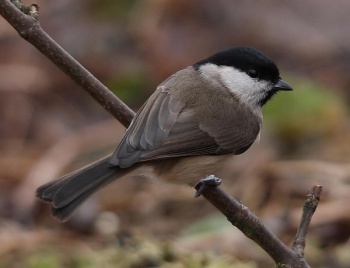- Poecile palustris
Parus palustris
Identification
11–13 cm (4¼-5 in)
Large shiny black cap, small black bib. grey brown upperparts, dull buff underneath. Often has pale spot on upper mandible at base of bill as opposed to just pale edges as seen on Willow Tit. Cheek may have clear 'rusty looking' demarkation nearing the nape. Usually neat and dapper looking as opposed to the scruffy looking Willow Tit.

Photo © by James Thomas
Redhouse, North Yorkshire, UK, 22 January 2011
Similar Species
Very similar to Willow Tit.
Distribution
Taxonomy
Until recently, all Tit species were believed to belong to the same genus, Parus. Since then, research results appeared which made it more likely that the correct treatment was to divide the Tit/Chickadee species into several genera; Marsh Tit thereby became a member of the genus Poecile. Black-bibbed Marsh Tit (Poecile hypermelaena) is a recent split from the regular Marsh Tit.
Subspecies
There are 8 subspecies[1]:
- P. p. palustris:
- British Isles, southern Scandinavia and central Europe to Pyrenes and the Balkans
- P. p. stagnatilis:
- Western Russia to northern Turkey, eastern Yugoslavia and Bulgaria
- P. p. kabardensis:
- Caucasus Mountains
- P. p. italicus:
- French Alps and Italy
- P. p. brevirostris:
- P. p. ernsti:
- Sakhalin
- P. p. hensoni:
- Northern Japan (southern Kuril Islands and Hokkaido)
- P. p. hellmayri:
Habitat
Prefers deciduous woodland.
Behaviour
Breeding
Moss and grass cup in existing hole either in tree or wall.
Diet
It eats mainly insects in summer, seeds and berries in autumn and winter. Will use feeders.
Vocalisation
Its voice is a most distinctive sneezing sound.
References
- Clements, J. F., T. S. Schulenberg, M. J. Iliff, D. Roberson, T. A. Fredericks, B. L. Sullivan, and C. L. Wood. 2018. The eBird/Clements checklist of birds of the world: v2018. Downloaded from http://www.birds.cornell.edu/clementschecklist/download/
- Brazil, M. (2009). Birds of East Asia. Princeton Univ. Press.
- Eck, S., & Martens, J. (2006). Systematic notes on Asian birds. 49. A preliminary review of the Aegithalidae, Remizidae and Paridae. Zoologische Mededelingen, 80:1-63.
- Gosler, A., Clement, P. & Garcia, E.F.J. (2017). Marsh Tit (Poecile palustris). In: del Hoyo, J., Elliott, A., Sargatal, J., Christie, D.A. & de Juana, E. (eds.). Handbook of the Birds of the World Alive. Lynx Edicions, Barcelona. (retrieved from http://www.hbw.com/node/59859 on 24 June 2017).
- Harrap, S. & Quinn. D. (1995) Chickadees, Tits, Nuthatches & Treecreepers. Princeton Univ. Press.
- Scott G.W. (1999) Separation of marsh tits parus palustris and willow tits parus montanus, Ringing & Migration, 19:4, 323-326, DOI: 10.1080/03078698.1999.9674201
Recommended Citation
- BirdForum Opus contributors. (2024) Marsh Tit. In: BirdForum, the forum for wild birds and birding. Retrieved 18 April 2024 from https://www.birdforum.net/opus/Marsh_Tit
External Links
GSearch checked for 2020 platform.1






